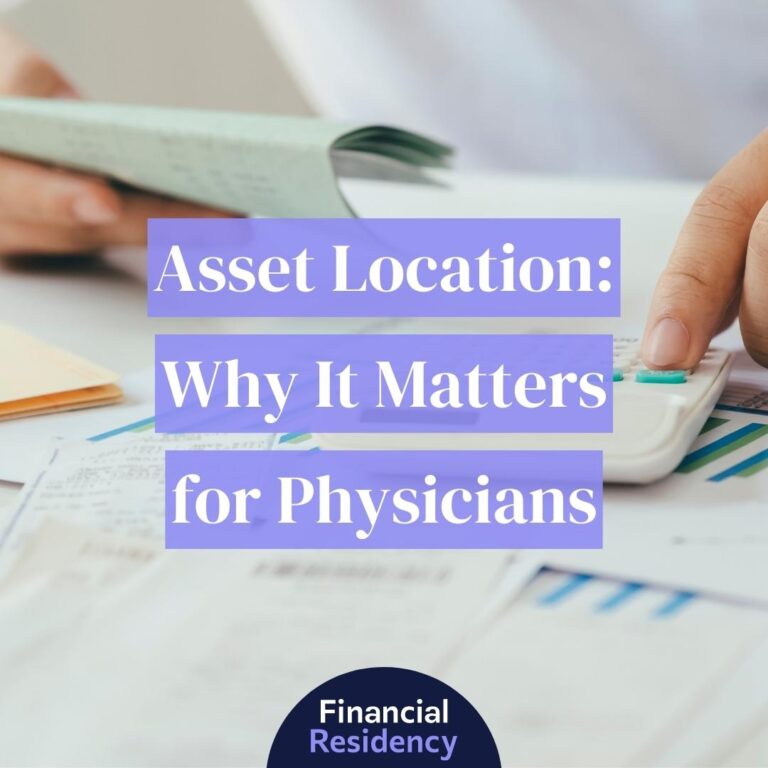As a high-income earner, it’s imperative that you have an understanding of the tax benefits of charitable contributions.
Income tax can significantly take away from your ability to grow investments, make a difference in your community, and share your resources with your family, especially if you’re in the upper tax rates. However, there are a few important strategies that can help you work within the confines of the Internal Revenue Services’ codes while also living in alignment with your values.
We researched the ins and outs of the United States tax code to write this physician’s guide to charitable contributions.
Tax Preparation Tips
Tax planning is half the battle to knowing what to expect from your financial future. Adding charitable giving to your tax strategy can help you make the most of your high-earning potential by reducing your taxable income.
Lowering your taxable income can allow you to redirect necessary funds to the causes that need it the most.
Only itemize if your expenses exceed the standard deduction
In the 2022 tax year, the standard deduction for single filers is $12,950, $25,900 for married joint filers, and $19,400 for heads of household. While as little as 10% of American taxpayers submit itemized deductions, it’s far more common for physicians and other high-income earners.
You will only qualify for tax deductions for your charitable contributions if your expenses exceed the standard deduction. If you’ve previously donated and not received tax benefits, you may have learned this firsthand, but you can learn new strategies for future tax years.
If your charitable contributions exceed the standard deduction, you’ll need to itemize your deductions in order to receive tax benefits for your charitable donations.
Claiming charitable contributions on Schedule A can give physicians access to major tax savings, especially if they’re currently in a phase-out range.
Save Your Receipts
If you intend to do an itemized deduction, you’ll need proof of expenses by way of receipts, canceled checks, bank statements, written records, or photographic evidence.
You can store these as hard copies in a file folder, submit them to your accountant throughout the year, or scan them into your computer for a paperless storage solution.
Take Advantage of Small Business Tax Deductions
For physicians who own a private practice, it’s important to separate business and personal expenses. An accountant can advise you on the best methods to separate personal and business expenditures so you can maximize your tax savings.
Small businesses are eligible for tax deductions when they donate non-food inventory, food, and intellectual property.
Consider Donating Appreciated Assets to Avoid Capital Gains Tax
If you own an appreciated asset such as real estate, stock, or other property, you can donate it to charity without paying the full capital gains tax you’d have to pay if you had sold it outright.
It’s important to note that these savings only apply to property owned for at least one year. If you’ve considering unloading an appreciated asset, talk to a financial advisor to find the most tax-efficient strategies for your financial situation.
How To Value Your Charitable Contributions
You can value your donated items to the IRS by consulting a private financial advisor with experience with fair market values in your area. The law states that a charity can’t determine the market value for the donations it receives.
Does the IRS ask for proof of charitable donations?
Yes, the IRS asks for proof of all charitable donations if you plan to deduct them. Charitable contributions of any amount require bank records (such as credit card or bank account statement) or written communication with a qualifying organization detailing the exact donation amount, name of the organization, and date received.
For donations over $250, the organization must provide a written acknowledgment of the donated amount and a description of what was donated. This rule applies to property and cash.
What documentation do you need for charitable contributions?
You will need to submit various documentation to claim charitable contributions on your tax return. Different charitable contribution amounts require different documentation.
For example, charitable contributions below $250 can be deducted with a written acknowledgment from the qualified charity you donated to and a bank statement.
Donations over $250 will require a more detailed written acknowledgment from the organization, including a description of the cash or property donated. Noncash donations over $500 but less than $5,000 will require you to file Form 8283, Section A. Noncash donations of higher values will require an appraisal by a qualified third party.
The IRS Internal Revenue Code Publication 526 outlines the required documentation taxpayers must submit to qualify for a tax deduction for charitable contributions.
Talk to your CPA about your cash contributions and any other charitable gifts to make the most of your deduction amounts.
7 Most Tax-Efficient Ways to Donate to Charity
Here are some of the most tax-efficient ways to donate to charity. If you are planning to make a habit of charitable giving, become familiar with tax law so you can make the most of your deductions and minimize your tax liability.
1. 529 Education Fund
You can give up to $17,000 as a single filer or $34,000 if you’re filing jointly to a 529 education plan.
The tax benefits of contributing to a 529 fund can vary depending on the state you live in as some states will offer state income tax deductions if you contribute to your state’s fund whereas others will offer deductions regardless of where your plan is based.
The federal tax code also allows taxpayers to front-load up to five years of contributions to a 529 fund in a single tax year.
There’s even a trick where you can contribute up to six years if you pay the annual limit in December and then another five years in January.
2. Financial Gifts
Because 529 funds are limited to education, it’s not the best option for everyone.
If you have relatives or loved ones who wouldn’t benefit from an education fund, you can begin gifting them up to $17,000 annually as a single filer or $34,000 as a married couple without paying a federal gift tax.
3. Securities to Charitable Organizations
Securities are tradable financial assets. They can be donated directly to a charitable organization or you can sell them first and donate the funds.
The right option for your financial needs will depend on whether or not the securities are a long-term appreciating asset or they’ve depreciated over time.
If the asset has appreciated, donating the security allows taxpayers to take a deduction that can offset capital gains tax. If the asset depreciated, it can be more financially prudent to sell it first, document the losses, and then donate the proceeds from the sale.
4. Donor-Advised Fund (DAF)
Donor-advised funds are similar to 401(k)s in that they have managed funds that grow tax-free. When you contribute to a donor-advised fund, you can take an immediate tax deduction without having to choose a charity to donate to.
You can simply allow the money to grow and make a future contribution from that fund to a charity of your choice when you’re ready. Donor-advised funds also simplify the giving process by allowing you to keep track of charitable contributions in one account rather than multiple donations spread out over the tax year.
DAFs allow you to deduct up to 60% of your AGI for cash donations and up to 30% for appreciated assets.
5. Charitable Remainder Annuity Trust (CRAT)
A Charitable Remainder Annuity Trust (CRAT) can provide aggressive interest earning and an annual income stream for the owners of the fund.
When the trust is opened, the owner of the fund receives a deduction for that tax year. At the end of the trust term, the assets in the trust are donated to charity or charities outlined in the trust agreement.
6. Start a Private Foundation
A private foundation can be structured in two ways––an operating foundation or a non-operating foundation. An operating foundation directly manages the charity and executes its mission. A non-operating foundation is similar to a DAF in that it makes contributions to charities to support various efforts.
Starting a private foundation can allow you to make contributions to charities that don’t qualify for tax deductions while still reaping the tax benefits.
Private foundation donations will allow you to deduct up to 30% of your AGI for cash donations and 20% of your AGI for appreciated assets.
7. Consider a Combined Gift
A combined gift is a charitable contribution that includes both cash and securities. In some cases, donating both at the same time can provide greater tax benefits than just donating securities on their own.
Combined gifts are particularly advantageous for high-income years. In general, securities and stocks held for at least one year are tax deductible at their fair market value.
The IRS has a specific order for determining which deductions can be taken first, so it’s important to discuss your options with a qualified CPA or financial advisor to understand the most tax-advantageous donating strategy for your cash and appreciated assets.
Charitable Contribution vs. Tax Credit
The difference between deducting donations and taking a tax credit is that a tax deduction reduces the amount of income you owe taxes on whereas a tax credit reduces the amount of taxes you owe or increases your refund.
Said differently, tax deductions lower your taxable income whereas a tax credit lowers your tax bill dollar-for-dollar. When you lower your taxable income, you can effectively lower your tax rate.
Individuals and joint filers can subtract expenses related to the following from their tax bills:
- Work-related deductions
- Itemized deductions
- Education deductions
- Healthcare deductions
- Investment relation deductions
Individuals and joint filers may receive tax credits for the following:
- Family and dependent caregiving
- Income and savings
- Homeowner incentives
- Electric vehicles
- Healthcare
A CPA or financial advisor can help you understand if your expenses qualify for a tax deduction or credit.
The IRS Charity List
The IRS charity list is a database of tax-exempt organizations, non-profits, and charities that meet the requirements for givers to deduct their charitable contributions.
The IRS’s Tax Exempt Organization Search Tool (TEOS) is the go-to resource for finding out if an organization you intend to donate to qualifies for a charitable deduction on your taxes.
According to Internal Revenue Code, section 170(c), as of August 25, 2022, qualified charities may be one of the following:
- A state or United States possession (or political subdivision thereof), or the United States or the District of Columbia, if made exclusively for public purposes;
- A community chest, corporation, trust, fund, or foundation, organized or created in the United States or its possessions, or under the laws of the United States, any state, the District of Columbia or any possession of the United States, and organized and operated exclusively for charitable, religious, educational, scientific, or literary purposes, or for the prevention of cruelty to children or animals;
- A church, synagogue, or other religious organization;
- A war veterans’ organization or its post, auxiliary, trust, or foundation organized in the United States or its possessions;
- A nonprofit volunteer fire company;
- A civil defense organization created under federal, state, or local law (this includes unreimbursed expenses of civil defense volunteers that are directly connected with and solely attributable to their volunteer services);
- A domestic fraternal society, operating under the lodge system, but only if the contribution is to be used exclusively for charitable purposes;
- A nonprofit cemetery company if the funds are irrevocably dedicated to the perpetual care of the cemetery as a whole and not a particular lot or mausoleum crypt.
How to Spot Charity Scams
The Federal Trade Commission (FTC) recommends being vigilant about the possibility of charity scams because donating to non-qualified organizations will not result in tax benefits.
You can spot charity scams by researching every organization before donating. You can cross-check the name of the charity with your state representative from the National Association of Charity Officials to confirm the state is registered.
The Better Business Bureau can be another avenue for researching frequent complaints and the general reputation of the organization.
You’ll also want to consult the IRS charity list to confirm your donation is eligible for a tax deduction.
If you ever receive a knock at your door or a phone call soliciting donations, take a moment to pause, ask for a hard copy of any informational materials they have, and verify the name of the organization.
Avoid sending cash whenever possible so that you can provide proof of a transaction if you choose to itemize your deductions.
It’s not uncommon for charity scammers to use the name of an easily recognizable entity, but there will be slight differences in spelling, punctuation, or the website you’re directed to.
Frequently Asked Questions
What percentage of your income can you deduct without a receipt?
You can’t deduct a percentage of your income without a receipt. The maximum amount you can deduct without a receipt is $300.
During the pandemic, the Coronavirus Aid, Relief, and Economic Security Act (CARES) raised this limit to $600, but this act was a temporary measure and it’s not a permanent amendment to tax law.
What is the difference between a 30% charity and a 50% charity?
The difference between a 30% charity and a 50% charity is the tax deduction you can take when you donate to that organization.
A 30% charity will only qualify you to deduct 30% of your adjusted gross income (AGI) and a 50% charity will qualify you to deduct 50% of your AGI.
The rules for noncash donations are more complicated. If you choose to donate capital gains property to a 50% charity, your tax deduction for donating that property is limited to 30% of your AGI.
If you donate the same property to a 30% charity, your tax deduction is limited to 20% of your AGI. However, you can deduct the excess for up to five years if your charitable contributions exceed these limits.
What’s the difference between a one-time donation and a monthly donation?
The difference between a one-time donation and a monthly donation is a one-time donation is made once whereas monthly donations are recurring. Monthly donations make a big impact on organizations’ cash flow, which can allow them to make a difference year-round.
It can also allow donors to spread their investment in a cause across the calendar year rather than make a larger one-time donation.
How does donating to charity help the economy?
Donating to charity helps the economy in the following ways, especially if you choose to donate to a local organization:
- Funnels money into your community: When you donate to a charitable organization that spends its money within the community, the money stays within the local economy, which can create jobs and support small businesses.
- Improves resource access: When charitable organizations have the resources to invest in new programming, hire new personnel, or spread the word about their mission, their impact can grow.
- Builds lasting relationships: Donating time, money, skills, or expertise can create valuable bonding and networking opportunities within the community. These lasting relationships can improve the reach of the organization and attract more donations.
- Motivates others: When people feel supported or involved in their communities, they are more likely to engage with each other positively. Motivated people will continue to show up for their communities, spend money at small businesses, and build their lives around the local economy.
- Makes your hometown an even better place to live: Donating to your hometown’s infrastructure, medical care access, poverty care, and other safety nets can aid organizations in addressing the root causes of these issues.




